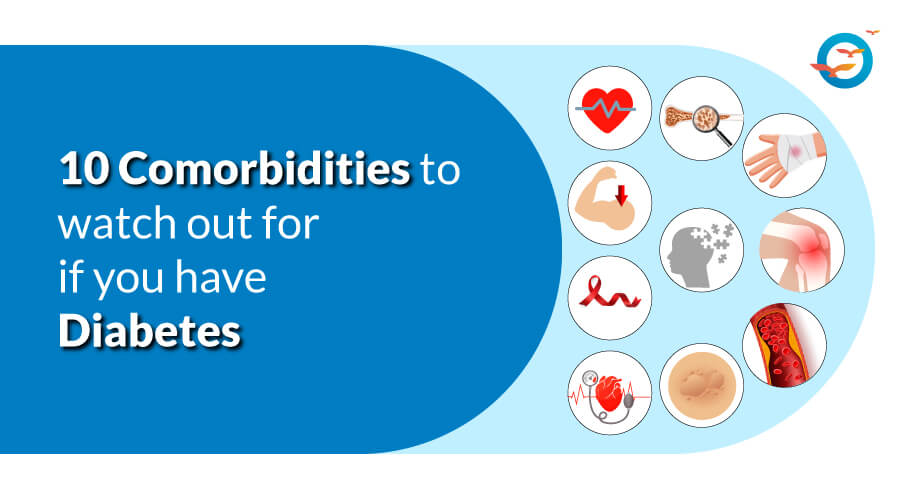10 Common comorbidities of diabetes

Unhealthy diets combined with lack of physical exercise and high-stress levels are known to trigger a phenomenon known as insulin resistance. Insulin resistance is the underlying root cause of a quiet pandemic of so-called “lifestyle disorders”, the most deadly of these is diabetes.
The real danger of diabetes is the insidious effect of high blood sugar on the various organs of your body—large and small. Over time, and if left untreated, diabetes invariably gets worse, bringing myriad health complications.
Here are the 10 comorbidities most likely to come in the wake of diabetes
1. Heart disease
Statistically, diabetics are at least 50% more likely to suffer from heart disease, and they tend to get it at a younger age than people without diabetes. Both diabetes and heart disease have some common risk factors: smoking, obesity, lack of exercise, high-fat diets, and alcohol overconsumption are commonly seen in both these conditions. That also means that the measures that work to manage blood sugar levels (BSL) are equally effective in lowering the risk of heart damage.
In other words, taking care of your diabetes is the first step toward enabling your heart to protect itself. This means making deep changes to your lifestyle, starting with your diet. A heart-healthy diet—and one that works to manage BSL—is one that is low in high Glycemic Index foods, i.e. foods that do not spike BSL. Foods rich in complex carbs, fiber, protein, and micronutrients like antioxidants are considered good for both the heart and BSL.
It is also important to combine a healthy diet with an active lifestyle that incorporates at least 150 minutes of exercise a week. Losing weight is another important preventive measure. Losing even 5% to 10% of one’s body weight has a significant impact on heart health improvement and BSL. Stress management is another key aspect of BSL management.
Including habits like meditation in one’s daily routine can help reduce stress and lower the risk of heart disease. You can learn more about how to lower your risk of heart problems if you have diabetes, read our article: Diabetes and heart disease: How to keep your heart healthy.
2. Joint Pain
Uncontrolled or improperly managed BSL can cause significant damage to the musculoskeletal system leading to compromised mobility and pain. Almost half of all adults with diabetes end up with arthritis as well. This is a result of high BSL that damages nerves and blood vessels, which goes on to erode the cartilage that cushions joints.
This brings pain, inflammation, and soreness. Eventually, it can lead to diabetic neuropathy, a condition caused by damage to the nervous system. To learn more about this comorbidity and how you can avoid it, read: Type 2 diabetes-related joint pain, and what you can do about it.
3. Muscle mass loss
Everyone wants to be more muscular but none need it more than diabetics. The medical establishment, which traditionally recommended walking as the best exercise for diabetics, now acknowledges the critical role played by muscle mass. After all, it is a muscle that burns glucose, so it follows that the more muscle you have the higher your calorie-burn rate.
However, research shows that as we age muscle tends to atrophy—which could also explain why diabetes is so prevalent in older populations. But recent studies have emerged that show that this loss of muscle mass is also caused by specific proteins, and these are more active and prevalent in diabetics. You can learn more about their role in muscular atrophy and their connection to insulin resistance, here.
4. Slow-healing wounds
This condition may not, at first glance, seem like serious comorbidity, but it often has serious consequences, that commonly affect diabetics. One of the most common symptoms of mismanaged diabetes is slow-healing wounds. Lack of sensitivity—caused by nerve damage—most often seen in the lower extremities means that cuts, blisters, and small sores can go unnoticed, becoming a breeding ground for harmful bacteria.
This leads to open wounds, which the body is unable to quickly fight off owing to its compromised immunity, due to high BSL. Beyond a point, these wounds can lead to potentially fatal sepsis or amputation. If you’re diabetic there are some warning signs to watch out for, including tingling sensations, burning in the legs or lower limbs, lack of sensation, and persistent pain or swelling.
If you notice any such sign, contact your doctor immediately and ensure you follow their treatment directions to avoid aggravating the wound. There are some basic steps diabetics should take to prevent suffering from long healing wounds, and you can find details on this in our article: Diabetes and slow healing wounds—reasons, treatment, and prevention
5. Hypertension (High BP)
Like diabetes, hypertension too attacks silently. This is why a large percentage of diabetics also have high BP. Another common factor these two disorders share is their most likely cause: insulin resistance. Because of the lack of symptoms, it is very important for every adult to periodically test their BP. If it is above 120/80, you could be heading for hypertension.
One of the primary causes of diabetic hypertension is plaque build-up on arterial walls, which is caused by high LDL cholesterol (aka, “bad” cholesterol). This plaque buildup leads to the narrowing and hardening of the arteries. As a result, the heart has to pump harder for blood to reach all parts of the body, effectively raising blood pressure.
Because diabetes and high BP share many of the same root causes, their treatment too has many common features. Another shared feature that both diabetes and hypertension have is the markedly high risk of health complications. Without proper treatment, they can lead to such complications as vision problems, heart attack, strokes, and kidney damage, among others.
Losing weight is the first step in reducing risk and preventing complications. And this means, switching to a healthy diet, getting regular exercise, managing stress, stopping smoking, and reducing alcohol consumption. Whether you’re hypertensive or not, if you happen to be suffering from diabetes, this article is a must-read for you: Hypertension and diabetes: Risks, complications, and treatment.
6. Skin Problems
Sometimes, warnings of impending or nascent health problems are right before our eyes. All we need is the understanding and knowledge to correctly discern an incipient problem.
The skin—our largest organ by size—is one such health barometer. Our article: Ten ways your skin may be warning you of diabetes, shares some of the most common signs of high blood sugar. If you notice any of these problems, contact your doctor as early as possible.
7. High Cholesterol
Everyone has cholesterol. Your body needs it for a number of metabolic activities, like the production of bile, the synthesis of fat, and the absorption of nutrients. But there are two types of cholesterol one good and—High-Density Lipoprotein (HDL)—the other not so much.
When the level of “bad” cholesterol—Low-Density Lipoprotein (LDL)—gets elevated it can lead to heart attacks and strokes. Studies suggest a definite link between diabetes and low HDL levels & high LDL levels.
This condition, known as diabetes dyslipidemia, is quite common in type two diabetics. Even diabetics with good blood sugar control have been found to suffer from high LDL levels. With poor blood sugar management, the condition just becomes worse.
One reason that diabetics suffer from high LDL cholesterol is that diabetics generally have smaller and denser LDL molecules than non-diabetics. This means the LDL particles can get into blood vessels more easily, and deposit plaque on the artery walls that is more difficult to dislodge as they are denser.
Since both these conditions are linked, treating one controls the other as well. Thus good blood sugar management is key to reducing cholesterol. To learn more about the link between diabetes and cholesterol, and how to manage it, read: Diabetes and high cholesterol: what’s the connection?
8. Cancer
Diabetics today are generally aware of the health risks they face from complications like hypertension, heart disease, and kidney damage. These are serious enough issues. Now, new evidence shows that diabetics are also at higher risk from one of the deadliest diseases—Cancer!
Statistics show that diabetes doubles the risk of some cancers, such as cancer of the liver, pancreas colorectal, and breast cancer. Some of the risk factors common to both diabetes and cancer, include age, lack of nutritious diets, insufficient or no physical activity and stress.
These factors are also known to increase inflammation—a key cause of insulin resistance and higher cancer risk. It is obvious that treating one will also benefit the other. Our article: Understanding the Diabetes-Cancer Link will help you understand how high BSL increases your risk of cancer and offers actionable steps to protect yourself.
9. Memory loss
Memory loss is a natural side-effect of ageing. Diabetes is a result of insulin resistance. Both seem to be mutually exclusive, but evidence points to a definite link between dementia and diabetes. Studies suggest that this is partly due to the damage that high blood sugar causes to the blood vessels of the brain.
Over time it leads to a condition known as vascular dementia. Research also suggests that the functioning of insulin receptors in the brain is impacted when they sense that insulin levels in the body are not balanced, raising the risk of dementias, like Alzheimer’s disease.
Age and genetics do play a role in raising the risk of dementia, but bringing your BSL under control has been shown to be effective in reducing the risk. In addition to diet and exercise, one can also keep the brain active through stimulating activities, avoiding tobacco and alcohol, etc. Read our article on the topic, here, to understand if you could be at risk and how you can avoid it.
10. Fragile bones, and joint problems
High blood sugar—which is caused by insulin resistance and is the underlying cause of diabetes—affects almost every part of the body. One of these, albeit little known, comorbidities is fragile bones and joints.
This health complication encompasses a host of disorders from common ones, like frozen shoulder and diabetic hand syndrome to more serious ones like Charcot’s joint, and osteoarthritis.
Since the root cause is high blood sugar, which weakens muscles and increases the fragility of joints, it follows that reversing the problem, i.e. normalizing BSL, will help reduce the risk of joint problems. Read our article on Bone and joint disorders caused by diabetes
Reverse Diabetes to Reverse Comorbidities
Diabetes is the first domino in the pile of disorders. Once it falls, a host of health complications inevitably follow. Managing BSL helps reduce the risks, but you don’t have to stop there. FFD’s Holistic Transformation Program (HTP) offers a step-by-step, guided program that has helped tens of thousands of diabetics across the world totally reverse their diabetes and many of their other health complications as well. You can find more information about our HTP program, here.

